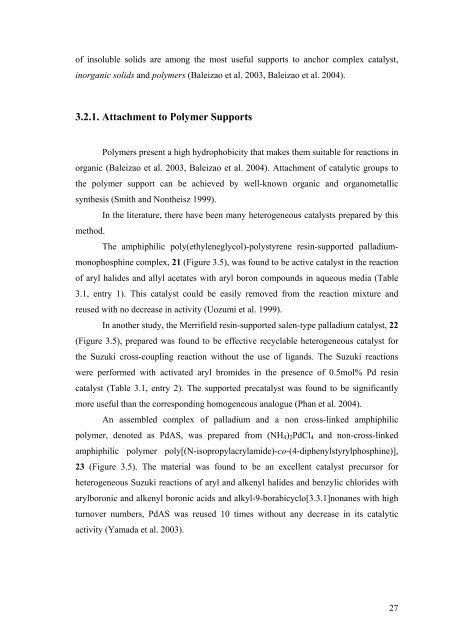chapter 2 palladium catalysts in suzuki cross- coupling reaction
chapter 2 palladium catalysts in suzuki cross- coupling reaction
chapter 2 palladium catalysts in suzuki cross- coupling reaction
Create successful ePaper yourself
Turn your PDF publications into a flip-book with our unique Google optimized e-Paper software.
of <strong>in</strong>soluble solids are among the most useful supports to anchor complex catalyst,<br />
<strong>in</strong>organic solids and polymers (Baleizao et al. 2003, Baleizao et al. 2004).<br />
3.2.1. Attachment to Polymer Supports<br />
Polymers present a high hydrophobicity that makes them suitable for <strong>reaction</strong>s <strong>in</strong><br />
organic (Baleizao et al. 2003, Baleizao et al. 2004). Attachment of catalytic groups to<br />
the polymer support can be achieved by well-known organic and organometallic<br />
synthesis (Smith and Nontheisz 1999).<br />
method.<br />
In the literature, there have been many heterogeneous <strong>catalysts</strong> prepared by this<br />
The amphiphilic poly(ethyleneglycol)-polystyrene res<strong>in</strong>-supported <strong>palladium</strong>-<br />
monophosph<strong>in</strong>e complex, 21 (Figure 3.5), was found to be active catalyst <strong>in</strong> the <strong>reaction</strong><br />
of aryl halides and allyl acetates with aryl boron compounds <strong>in</strong> aqueous media (Table<br />
3.1, entry 1). This catalyst could be easily removed from the <strong>reaction</strong> mixture and<br />
reused with no decrease <strong>in</strong> activity (Uozumi et al. 1999).<br />
In another study, the Merrifield res<strong>in</strong>-supported salen-type <strong>palladium</strong> catalyst, 22<br />
(Figure 3.5), prepared was found to be effective recyclable heterogeneous catalyst for<br />
the Suzuki <strong>cross</strong>-coupl<strong>in</strong>g <strong>reaction</strong> without the use of ligands. The Suzuki <strong>reaction</strong>s<br />
were performed with activated aryl bromides <strong>in</strong> the presence of 0.5mol% Pd res<strong>in</strong><br />
catalyst (Table 3.1, entry 2). The supported precatalyst was found to be significantly<br />
more useful than the correspond<strong>in</strong>g homogeneous analogue (Phan et al. 2004).<br />
An assembled complex of <strong>palladium</strong> and a non <strong>cross</strong>-l<strong>in</strong>ked amphiphilic<br />
polymer, denoted as PdAS, was prepared from (NH4)2PdCl4 and non-<strong>cross</strong>-l<strong>in</strong>ked<br />
amphiphilic polymer poly[(N-isopropylacrylamide)-co-(4-diphenylstyrylphosph<strong>in</strong>e)],<br />
23 (Figure 3.5). The material was found to be an excellent catalyst precursor for<br />
heterogeneous Suzuki <strong>reaction</strong>s of aryl and alkenyl halides and benzylic chlorides with<br />
arylboronic and alkenyl boronic acids and alkyl-9-borabicyclo[3.3.1]nonanes with high<br />
turnover numbers, PdAS was reused 10 times without any decrease <strong>in</strong> its catalytic<br />
activity (Yamada et al. 2003).<br />
27

















